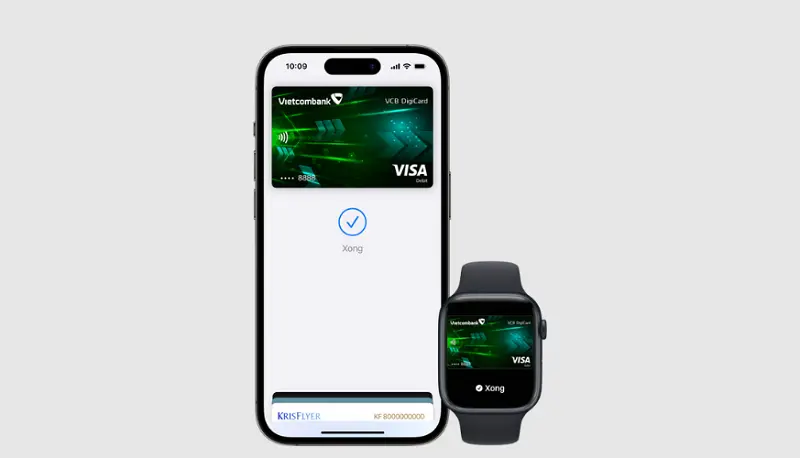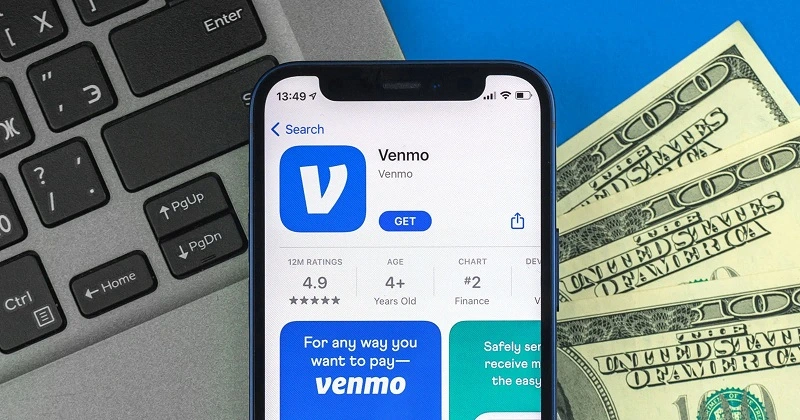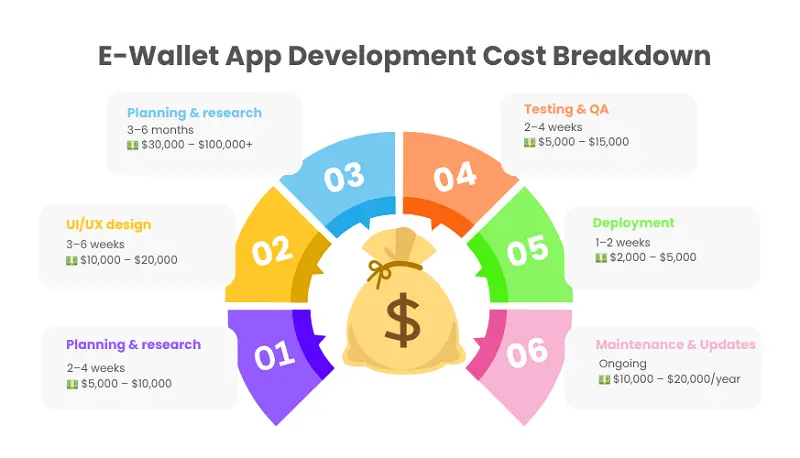Planning to build an e-wallet app but not sure how to budget for it? E-wallet development costs can vary widely depending on the app’s features, platforms, and the team you hire.
In this guide, you’ll learn the estimated cost range for developing an e-wallet app in 2025. We’ll cover the key cost factors, real-world examples, and a detailed phase-by-phase breakdown to help you budget accurately and avoid unexpected expenses.
How much does E-wallet cost? (Overview)
E-wallet app development costs can differ a lot, starting at $10,000 for a simple MVP and going beyond $250,000 for advanced versions. Check the table below for more specifics:
| App type | Key features | Estimated cost | Development time |
|---|---|---|---|
| MVP (Minimum Viable Product) | – User registration & authentication – Basic wallet functionality (Add/Withdraw Funds) – Peer-to-peer (P2P) transfers – Transaction history – Basic security measures (e.g., PIN, password) | $10,000 – $30,000 | 2 – 4 weeks |
| Basic app | – All MVP features – Bill payments & mobile recharges – Bank account integration – Push notifications – Enhanced security (e.g., Two-factor authentication) | $25,000 – $50,000 | 2- 4 months |
| Medium app | – All basic app features – Multi-currency support – Budgeting tools & expense tracking – QR code payments – Loyalty programs & cashback offers – Advanced security (e.g., Biometric authentication) | $50,000 – $100,000 | 6 – 9 months |
| Complex app | – All medium app features – Cryptocurrency integration AI-powered financial insights – Investment & savings modules – Regulatory compliance – Features (e.g., KYC, AML) – 24/7 customer support chatbot – Admin dashboard with analytics | $100,000 – $250,000+ | 9–12+ months |
Key factors influencing E-wallet app development cost
Next, we’ll explore each component in depth to understand how it impacts the overall e-wallet mobile app development cost.
Features
The e-wallet mobile app development cost largely depends on the features included. Apps with standard functionalities such as user registration, balance viewing, and P2P transfers are typically more budget-friendly.
However, adding advanced features (like biometric login, real-time fraud detection, offline payments, or support for multiple wallets and currencies) can drive up the cost. These enhancements require robust backend systems, tighter security protocols, and thorough testing.
Moreover, integrating even one high-end feature can extend development time and demand specialized skills, which contributes to higher initial investment and ongoing maintenance expenses.
Choosing the right features to match your business goal and budget is crucial. We’ve outlined the average development costs for popular e-wallet app features as below:
| Feature | What to have | Estimated cost |
|---|---|---|
| User authentication & management | – User registration & login – User authentication | $5,000 – $12,000 |
| Core wallet features | – Wallet management – Peer-to-peer transfers – Transaction history | $15,000 – $35,000 |
| Payment methods | – Payment integration – Bill splitting – QR code payments – NFC payments | $15,000 – $30,000 |
| Security features (basic) | – User authentication security – Data encryption – Session management | $15,000 – $20,000 |
| Admin & notifications | – Admin dashboard, – Notifications | $10,000 – $15,000 |
| Advanced features | – Virtual cards, – Cryptocurrency support, – Advanced analytics | At least $15,000 |
Third-party integrations
When building an e-wallet app, integrating third-party services like payment gateways, KYC/AML services, or banking APIs, requires additional development work. Developers need to set up workflows, manage varying data formats, and ensure that each integration meets strict security and compliance standards. This requirement can extend the development timeline by several weeks and significantly increase initial costs.
Beyond development, the integrations come with ongoing fees. For example, KYC providers often charge $1–$3 per verification, while payment gateways typically take a 2–3% cut per transaction. As your user base grows, these costs can rise quickly.
Plus, integrations requires regular maintenance, updates, and monitoring to stay aligned with API changes or regulatory updates. The more you add, the more time and money it takes to keep things running smoothly.
These are some of the most common third-party services integrated into e-wallet apps, along with their average pricing:
| Integration type | Description | Estimated cost |
|---|---|---|
| Payment Gateways | Integrating services like Stripe, PayPal, or Square for processing transactions. | $5,000 – $20,000+ |
| Banking APIs | Connecting with banks to enable features like balance checks and fund transfers. | $10,000 – $30,000+ |
| KYC/AML Services | Implementing Know Your Customer and Anti-Money Laundering checks through services like Jumio or Onfido. | $5,000 – $15,000+ |
| Push Notification Services | Using platforms like Firebase Cloud Messaging or Twilio to send real-time alerts to users. | $2,000 – $5,000+ |
| Analytics Tools | Incorporating tools like Google Analytics or Mixpanel for user behavior tracking and insights. | $3,000 – $8,000+ |
UI/UX design requirements
UI/UX design has a significant impact on e-wallet app development cost. If you go with a simple, read-made design style, it may take only 80 to 120 hours. However, when a more customized design is required, featuring branded visuals, interactive flows, and polished transitions, the workload can increase to 200 to 300 hours.
Sensitive screens like PIN entry, biometric login, and transaction confirmation often require 40 to 60 extra hours due to the need for enhanced security and regulatory compliance.
A well-structured design process also involves 2 to 3 rounds of user testing and iteration. Each round takes 5 to 7 working days, contributing to higher cost.
Furthermore, if the app is designed separately for iOS and Android without a shared design system, design time may nearly double.
Moreover, involving multiple specialists, such as a UX researcher, UI designer, and motion designer, can add $1,000–$5,000 to the project, depending on the level you need:
| Role | Junior | Mid-level | Senior |
|---|---|---|---|
| UX Designer | $25 – $50 | $50 – $75 | $75 – $100+ |
| UI Designer | $20 – $40 | $40 – $60 | $60 – $90+ |
| UX Researcher | $44 – $53 | $53 – $62 | $62 – $72+ |
Platform selection
Platform selection directly affects development time, team structure, and long-term maintenance.
If you choose native development for iOS and Android, you’ll need to maintain two separate codebases. This usually involves two different teams, which doubles both workload and cost. However, it offers the best performance, strong security, and full access to native features like Apple Pay, biometric login, and NFC.
In contrast, cross-platform frameworks like Flutter or React Native use a single codebase for both platforms. This can reduce development time and cost by 30–40%. It’s ideal for MVPs or apps with basic features. Nonetheless it may not perform well with complex native integrations or high-security tasks, common requirements in e-wallet apps.
Web apps are even more cost-effective, often 50–70% cheaper than native development. They are faster to build, but lack key mobile features like push notifications, offline access, and native payments. Therefore, they are best suited for admin dashboards or limited-use interfaces, not full e-wallet functionality.
See the table below for specific figures:
| Platform | Estimated cost |
|---|---|
| Native iOS/Android | $70,000 – $90,000 |
| Cross-platform | $40,000 – $60,000 |
| Web app | $30,000 – $45,000 |
Development team
Your development team has a big impact on how much it costs to build your e-wallet app. If your e-wallet app need advanced features (like biometric login, real-time transaction tracking, etc), you’ll need experienced developers with fintech skills. These developers charge more. So, the more complex your app, the more you should expect to pay.
Location also matters. Hiring developers in the US, UK, or Western Europe can cost 3 to 4 times more than working with teams in Eastern Europe, India, or Southeast Asia.
You can check the table below for a clearer comparison:
| Role | Level | India & Vietnam | US & Western Europe |
|---|---|---|---|
| Backend Developer | Junior | $15 – $30 | $50 – $80 |
| Mid-Level | $30 – $45 | $80 – $120 | |
| Senior | $45 – $70 | $120 – $160+ | |
| Frontend Developer | Junior | $15 – $25 | $45 – $70 |
| Mid-Level | $25 – $40 | $70 – $100 | |
| Senior | $40 – $60 | $100 – $140+ | |
| Mobile Developer | Junior | $15 – $30 | $50 – $80 |
| Mid-Level | $30 – $45 | $80 – $110 | |
| Senior | $45 – $65 | $110 – $150+ | |
| DevOps Engineer | Junior | $20 – $35 | $60 – $90 |
| Mid-Level | $35 – $50 | $90 – $130 | |
| Senior | $50 – $70 | $130 – $170+ | |
| QA Engineer | Junior | $10 – $20 | $40 – $60 |
| Mid-Level | $20 – $30 | $60 – $90 | |
| Senior | $30 – $45 | $90 – $120+ | |
| Project Manager | Junior | $20 – $35 | $60 – $90 |
| Mid-Level | $35 – $50 | $90 – $130 | |
| Senior | $50 – $70 | $130 – $170+ |
Moreover, choosing between an in-house team or outsourcing affects both short-term budgets and long-term operational:
- Building an in-house team gives you more control, smoother communication, and better cultural alignment , but come with high fixed costs: salaries, benefits, workspace, equipment, etc.
- Outsourced (freelancers, offshore companies, or dedicated agencies) can reduce costs by 30 to 60%, though they require stronger project management and communication systems to keep everything on track.
If you choose to outsource, your payment model also affects the total cost. Fixed-price contracts give you clear budgeting but less flexibility if things change. Hourly billing is more flexible during design and testing, but you’ll need to monitor progress closely to avoid going over budget.
Other hidden costs
Beyond core development, several hidden costs can significantly increase your total e-wallet app development cost. Here’s what you should plan for:
- Infrastructure & scalability: As your user base grows, your backend must handle higher loads reliably. You’ll need to invest in cloud hosting, database services, server maintenance, and disaster recovery. These are recurring costs that can range from a few thousand to over $10,000 per month, depending on traffic and system complexity.
- App store deployment fees: To launch your app, you’ll pay $99 per year for Apple and a $25 one-time fee for Google Play. Beyond that, you may need to budget for App Store Optimization (ASO), visual assets, and time spent navigating app review or resubmission processes, especially when policies change.
- Legal & compliance costs: E-wallet apps must comply with financial and data regulations such as KYC, AML, PCI DSS, and GDPR. This often involves legal consultation, integrating verification systems, and passing formal audits. Depending on your target markets, these costs can add $10,000 to $50,000 or more to your budget.
- Ongoing maintenance & support: After launch, regular updates, bug fixes, performance monitoring, and customer support are necessary. These ongoing services typically cost 15–20% of your initial development budget annually and require a dedicated support team.
- Marketing & user acquisition: Building the app is only step one, you also need to attract users. A strong launch and ongoing marketing strategy can take up 20–30% of your total project budget. Depending on your channels, Customer Acquisition Cost (CAC) usually ranges from $10 to $50 per user in the fintech space.
Examples of E-wallet development cost
To show how the above factors affect costs, here are three real-world examples: PayPal, Apple Pay, and Venmo. Each reflects a different level of functionality and infrastructure.
PayPal

Estimated cost: $150,000 – $300,000+
Key features:
- Multi-currency support
- Peer-to-peer (P2P) transfers
- Bank account and card linking
- NFC payments
- Biometric authentication
- AI-based fraud detection
- Premium UI/UX design
Development timeline: Approximately 12–18 months
PayPal is one of the most expensive digital wallet to develop because of its global scale and technical complexity . It works in over 200 countries, supports 25+ currencies, and handles real-time currency conversion, which requires a powerful and scalable backend.
It also integrates with hundreds of banks and payment networks like Visa and Mastercard, each with its own security and technical requirements. On top of that, PayPal must comply with global regulations like PCI DSS, GDPR, AML, and KYC, and uses AI to detect fraud in real time.
Apple Pay

Estimated cost: $50,000 – $300,000
Key features:
- NFC-based contactless payments
- Device-specific security (e.g., Secure Enclave)
- Biometric authentication (Face ID, Touch ID)
- Integration with Apple Wallet
- Tokenization for secure transactions
Development timeline: Approximately 9–12 months
Apple Pay is costly to develop as it focuses heavily on security, hardware integration, and smooth performance. It uses tokenization and encryption, while payments are confirmed with Face ID or Touch ID for extra protection.
The system also depends on special hardware like the Secure Enclave, which makes development and testing more complex. To reach this level of safety and user experience, developers must spend a lot of time building and fine-tuning the system.
It also needs to follow strict financial rules and work quickly across different devices. All of this adds to the time and cost of development.
Venmo

Estimated cost: $75,000 – $175,000
Key features:
- Social feed for transactions
- P2P payments
- Bank account and card linking
- Transaction history
- Push notifications
- Optional cryptocurrency support
Development timeline: Approximately 6–9 months
Venmo costs more to build than a basic e-wallet app because it combines money transfers with social features. This e-wallet has a real-time social feed where users can see, like, and comment on each other’s transactions.
Even though it only works in the U.S., it still needs secure systems for linking bank accounts and cards, sending and receiving money instantly, and supporting cryptocurrency. These features require a strong, reliable infrastructure.
Additional features like transaction history, push notifications, emojis, and privacy controls further increase development and ongoing maintenance costs.
E-wallet app development cost breakdown by phase
Another way to plan your e-wallet app development cost is by breaking it down into key phases, as outlined below:

Planning & research
This is the initial strategy phase where you define the app’s purpose, target users, key features, and technical roadmap. It ensures that the project starts on the right track.
Estimated cost: $5,000 – $10,000
Timeframe: 2–4 weeks
Cost drivers:
- Business analysis and documentation
- Market and competitor research
- Technical architecture and feature list creation
- Initial team consultation (PM, developers, architects)
Cost-saving tip: You can reduce costs by doing preliminary market research yourself using free tools (like Google Trends, competitor apps, or Statista’s public data). Keep your feature list lean, define a Minimum Viable Product (MVP) to avoid overbuilding early.
UI/UX design
This stage delivers the look and feel of your app across platforms.
Estimated cost: $10,000 – $20,000
Timeframe: 3–6 weeks
Cost drivers:
- Designer fees (hourly or per screen)
- Prototyping and design tools (Figma, Sketch, Adobe XD)
- Cross-platform layouts (iOS, Android)
- User journey flows and usability testing
Cost-saving tip: It would be better to use pre-made UI kits or design systems (e.g., Google Material, Apple Human Interface) to speed up design work. Limit design to key screens first and expand only if necessary.
Development (Frontend + Backend)
This is the core stage where your app’s features and backend systems are built.
Estimated cost: $30,000 – $100,000+
Timeframe: 3–6 months
Cost drivers:
- Developer salaries or outsourcing fees
- Payment gateway and bank API integrations
- Secure backend (encryption, authentication, data handling)
- Multi-platform development (iOS, Android, web)
- Infrastructure setup (cloud services, databases, DevOps)
Cost-saving tip: You can lower your development budget significantly by working with Synodus, a provider known for offering high-quality solutions at a more affordable cost. Their agile teams specialize in e-wallet development and follow a streamlined, transparent workflow. This allows you to save both time and money while avoiding unnecessary complexity. If you’re looking for a partner that delivers efficiency without the high price tag, Synodus is a practical and budget-friendly choice.
Testing & QA
Here, you can ensure your app works reliably and securely.
Estimated cost: $5,000 – $15,000
Timeframe: 2–4 weeks
Cost drivers:
- Manual and automated test case creation
- Performance and security testing tools
- Cross-device and OS testing
- Bug fixing and retesting cycles
Cost-saving tip: You should automate repetitive test cases early using open-source tools (e.g., Selenium, Appium). Plus, focus testing efforts on high-risk features like payments and login first, before testing every minor detail.
Deployment
In this phase, your app is prepared and submitted to app stores (Apple App Store and Google Play) for users to download.
Estimated cost: $2,000 – $5,000
Timeframe: 1–2 weeks
Cost drivers:
- App store account fees (Apple: $99/year, Google: $25 one-time)
- Preparing store assets (screenshots, privacy policy, descriptions)
- Backend server configuration and domain setup
- Last-mile compliance and approval processes
Cost-saving tip: You can avoid delays (and extra cost) by carefully following Apple and Google’s submission guidelines. Use DevOps automation to simplify future updates and deployments.
Maintenance & updates
Once your app is live, you need to keep it running smoothly!
Estimated cost: $10,000 – $20,000 per year
Timeframe: Ongoing
Cost drivers:
- Developer time for bug fixes and improvements
- Server and infrastructure costs
- Updating for new OS releases and device types
- Adding features based on user feedback
- Customer service support (email/live chat)
Cost-saving tip: You should monitor your app’s performance using tools like Firebase Crashlytics or Sentry to proactively catch and fix issues. Moreover, schedule updates quarterly instead of reactively fixing small bugs one at a time — this lowers long-term cost.
Wrapping up
Developing an e-wallet app in 2025 can cost from $15,000 to over $300,000. This cost reflects what you want your app to do, basic transfers, bill payments, crypto support, or advanced security.
To decide your e-wallet app development cost, start by defining your app’s core goal. Are you building a quick MVP to test the market, or a full-featured app ready for scale? Each feature adds time, complexity, and cost.
Don’t aim for everything at once. Start small, with essential functions, then upgrade based on real user needs. This approach keeps your costs controlled, and your product focused.
How useful was this post?
Click on a star to rate it!
Average rating / 5. Vote count:
No votes so far! Be the first to rate this post.




